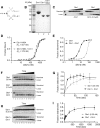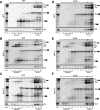A homolog of lariat-debranching enzyme modulates turnover of branched RNA
- PMID: 24919400
- PMCID: PMC4105757
- DOI: 10.1261/rna.044602.114
A homolog of lariat-debranching enzyme modulates turnover of branched RNA
Abstract
Turnover of the branched RNA intermediates and products of pre-mRNA splicing is mediated by the lariat-debranching enzyme Dbr1. We characterized a homolog of Dbr1 from Saccharomyces cerevisiae, Drn1/Ygr093w, that has a pseudo-metallophosphodiesterase domain with primary sequence homology to Dbr1 but lacks essential active site residues found in Dbr1. Whereas loss of Dbr1 results in lariat-introns failing broadly to turnover, loss of Drn1 causes low levels of lariat-intron accumulation. Conserved residues in the Drn1 C-terminal CwfJ domains, which are not present in Dbr1, are required for efficient intron turnover. Drn1 interacts with Dbr1, components of the Nineteen Complex, U2 snRNA, branched intermediates, and products of splicing. Drn1 enhances debranching catalyzed by Dbr1 in vitro, but does so without significantly improving the affinity of Dbr1 for branched RNA. Splicing carried out in in vitro extracts in the absence of Drn1 results in an accumulation of branched splicing intermediates and products released from the spliceosome, likely due to less active debranching, as well as the promiscuous release of cleaved 5'-exon. Drn1 enhances Dbr1-mediated turnover of lariat-intermediates and lariat-intron products, indicating that branched RNA turnover is regulated at multiple steps during splicing.
Keywords: Dbr1; Nineteen Complex; branched RNA; splicing.
© 2014 Garrey et al.; Published by Cold Spring Harbor Laboratory Press for the RNA Society.
Figures





Similar articles
-
The debranching enzyme Dbr1 regulates lariat turnover and intron splicing.Nat Commun. 2024 May 30;15(1):4617. doi: 10.1038/s41467-024-48696-1. Nat Commun. 2024. PMID: 38816363 Free PMC article.
-
Activation of human RNA lariat debranching enzyme Dbr1 by binding protein TTDN1 occurs though an intrinsically disordered C-terminal domain.J Biol Chem. 2023 Sep;299(9):105100. doi: 10.1016/j.jbc.2023.105100. Epub 2023 Jul 26. J Biol Chem. 2023. PMID: 37507019 Free PMC article.
-
Structure-function analysis of yeast RNA debranching enzyme (Dbr1), a manganese-dependent phosphodiesterase.Nucleic Acids Res. 2005 Nov 7;33(19):6349-60. doi: 10.1093/nar/gki934. Print 2005. Nucleic Acids Res. 2005. PMID: 16275784 Free PMC article.
-
DBR1 orchestrates the fate of lariat RNA: debranching-dependent turnover and function.Nucleic Acids Res. 2025 Jul 8;53(13):gkaf639. doi: 10.1093/nar/gkaf639. Nucleic Acids Res. 2025. PMID: 40637223 Free PMC article. Review.
-
Dbr1 functions in mRNA processing, intron turnover and human diseases.Biochimie. 2021 Jan;180:134-142. doi: 10.1016/j.biochi.2020.10.003. Epub 2020 Oct 8. Biochimie. 2021. PMID: 33038423 Review.
Cited by
-
The debranching enzyme Dbr1 regulates lariat turnover and intron splicing.Nat Commun. 2024 May 30;15(1):4617. doi: 10.1038/s41467-024-48696-1. Nat Commun. 2024. PMID: 38816363 Free PMC article.
-
Heterozygous pathogenic variants in CWF19L1 in a Chinese family with spinocerebellar ataxia, autosomal recessive 17.J Clin Lab Anal. 2022 Dec;36(12):e24767. doi: 10.1002/jcla.24767. Epub 2022 Nov 10. J Clin Lab Anal. 2022. PMID: 36357319 Free PMC article.
-
Crystal Structure of the RNA Lariat Debranching Enzyme Dbr1 with Hydrolyzed Phosphorothioate RNA Product.Biochemistry. 2022 Dec 20;61(24):2933-2939. doi: 10.1021/acs.biochem.2c00590. Epub 2022 Dec 9. Biochemistry. 2022. PMID: 36484984 Free PMC article.
-
SICKLE modulates lateral root development by promoting degradation of lariat intronic RNA.Plant Physiol. 2022 Aug 29;190(1):548-561. doi: 10.1093/plphys/kiac301. Plant Physiol. 2022. PMID: 35788403 Free PMC article.
-
CryoEM structures of two spliceosomal complexes: starter and dessert at the spliceosome feast.Curr Opin Struct Biol. 2016 Feb;36:48-57. doi: 10.1016/j.sbi.2015.12.005. Epub 2016 Jan 21. Curr Opin Struct Biol. 2016. PMID: 26803803 Free PMC article. Review.
References
-
- Arenas J, Hurwitz J 1987. Purification of a RNA debranching activity from HeLa cells. J Biol Chem 262: 4274–4279 - PubMed
-
- Braich RS, Damha MJ 1997. Regiospecific solid-phase synthesis of branched oligonucleotides: effect of vicinal 2′,5′- (or 2′,3′-) and 3′,5′-phosphodiester linkages on the formation of hairpin DNA. Bioconjug Chem 8: 370–377 - PubMed
Publication types
MeSH terms
Substances
Grants and funding
LinkOut - more resources
Full Text Sources
Other Literature Sources
Molecular Biology Databases
